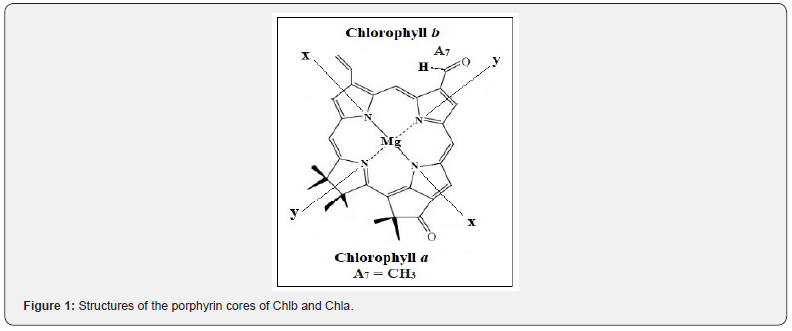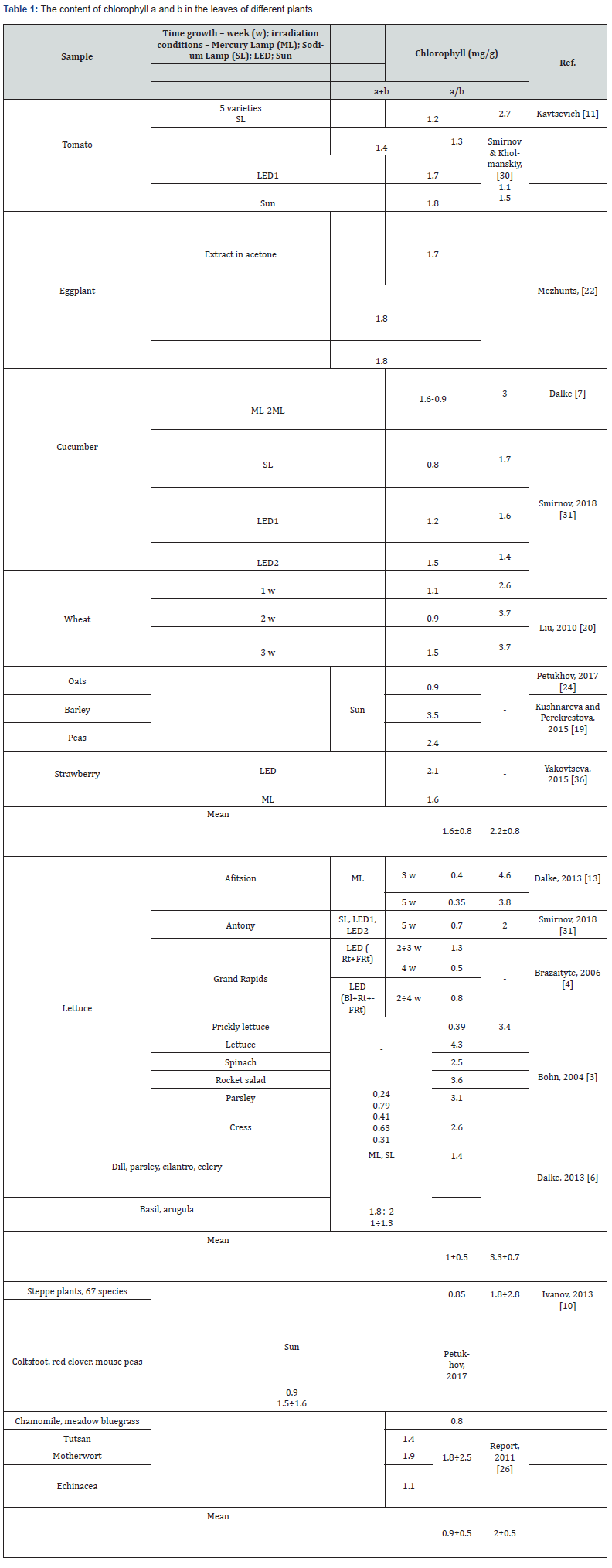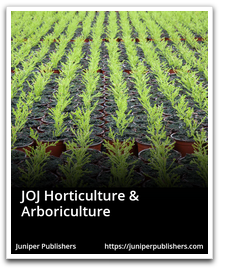Horticulture & Arboriculture - Juniper Publishers
Introduction
The productivity of photosynthesis of green plants is determined mainly by their genetics and strongly depends on temperature, nutrient medium and light regime Polevoj [25]; Andrianova & Tarchevskij [2]. These factors determine the structure and efficiency of the Photosynthetic Apparatus of the plant (PSA). The key functional elements of PSA are a and b forms of the Chlorophyll (Chl) Senge [28]; Kholmanskiy & Smirnov [16] and water, which plays the role of a dynamic matrix and active metabolite Polevoj [25]; Kholmanskiy & Tilov [13]; Aksenov [1]. Water sensitizes PSA by forming complexes with Mg and chiral centers Chl Kholmanskiy & Smirnov [16] and other molecules in the composition of PSA Senge [28]; Kholmanskiy [14]; Kholmanskiy [15]; Zaytseva & Sitanskaya [37]. The abnormal thermodynamic properties of water optimize the physics of cold stratification of seeds at a temperature of about 4°C Kholmanskiy [15] and minimize the energy of seed germination and photosynthesis in the temperature range 15-25°C Polevoj [25]; Kholmanskiy [15]. The photo- and thermophysics of Chl substantially depend on the Mg ion in the center of porphyrin cycle and the electronic nature of substituents in it Senge [28]; Kholmanskiy & Smirnov [16]. In principle, chlorophyll can play the role of a marker of the total Mg content in a plant and therefore can be considered an adequate characteristic of the nutritional value of a plant product.
The photochemistry and photo physics of PSA are determined primarily by the electronic structure of the ground and excited electronic states of Chl. A significant difference in the biophysics of chlorophyll Chl a and Chl b Tyutereva & Ivanova [35] is caused by the replacement of the CH3 group by the electron-acceptor and proton donor groups of CHO in the 7th position of pheophytin (Figure 1). In Frese [9]; Kholmanskiy & Smirnov [16], the electronic nature of the ground and lower excited states of Chl was attributed to states with charge transfers whose dipoles are oriented along the mutually orthogonal X and Y axes of the Chl molecule. The high dipole moments of the excited states of Chls initiate electron and proton transfers from other PSA components and these reactions can accelerate the kinetics of photochemical reactions in PSA. It was suggested in Kholmanskiy [18] that micro polarization of PSA promotes proton diffusion in leaves and intensifies the extraction of micro and macro cell ions by a plant. Mg and Chl greatly increase the nutritional and medicinal value of cultivated plants, both leafy and fruit-bearing. In Kholmanskiy [17-18] it was established that the efficiency of Mg extraction by plant leaves of cultivated plants depends on their species and responds to changes in the irradiation spectrum. It can be assumed that a similar dependence should be observed for the content of Chl in plant leaves. To deepen understanding of the biophysical relationship between plant productivity and Chl we compared the total content of a+b Chl and Mg in raw samples of leaves of a number of cultivated plants and steppe grasses. We analyzed the dependence of the Chl content in the leaves of cultivated plants on the light regime, and also compared the effects on photosynthesis of Chl a and Chl b in plantain and wheat seedlings of an electromagnetic industrial Novichkova & Podkovkin [23]; Shashurin [27] and an electrostatic vortex field Therapeutic reel Mishina [33].

Results and discussion
The empirical data on the content of chlorophylls a and b in cultivated plants and grasses were taken from books and works published by us and other authors. Table 1 shows the total content of Chl a+b (hereinafter [Chl]) and the ratio a/b for raw samples of plant leaves. The determination of [Chl] in the works was carried out according to the methods described in Lichtenthaler & Buschmann [21]. In Bohn [3] [Chl] was determined using liquid chromatography, and the Mg content in Chl was calculated based on its mass fraction of ~2.7% in a and b Chl. In this work, we compared the concentrations of total Mg and Mg in the composition of Chl (Table 2).


A large scatter of [Chl] values in different works is caused by differences in both their measurement methods and the growing conditions of the same plants. The [Chl] values determined for dry samples were recalculated for the wet state using a drying coefficient (k). It was evaluated by determining the weight of a fresh sample and after drying it at a temperature of no higher than 40°C. For vegetable crops (tomato, cucumber), leaf (lettuce, greens) and steppe grasses their k were: 8.5; 15-20 and 6-7, respectively. At the same time, the proportion of water in raw samples was determined by the ratio (k-1)/k and was equal to: 88%; 93-96% and 85-86%, respectively.
The Table 1 shows [Chl] values for plants growing in natural and greenhouse conditions. In the latter case, the age of the samples (weeks) and the light regimes were varied. The irradiators included various combinations of Blue (Bl), Green (Gr), Red (Rt) Light Emitting Diodes (LED1 and LED2) Kholmanskiy [18] and 400W high pressure sodium (SL) and mercury (ML) lamp. Their emission spectra and the absorption spectrum of Chl are shown in Figure. In some works, the LED composition included a diode emitting in the far-red region of the spectrum (FRt) with a maximum at 730nm. Plant species in Table 1 are divided into three groups: vegetables, cereals, berries (I); lettuce and greens (II); grasses (III). The mean values of [Chl] in the II and III groups are close and 1.6 times less than in the I group. At the same time, [Chl-b] in the I-st III-th is 2 times less than [Chl-a], and in the II-th one 3.3 times. The value of [Chl] in the first and second groups of plants reaches a maximum at 3 weeks of growth and depends on the spectral composition and intensity of irradiation. The Сhl content decreases when the irradiation intensity is exceeded by the norms of the optimal light regime Dalke [7]. Moreover, the Chl photo destruction reaction can contribute to the negative effect Kholmanskiy & Smirnov [16]. The efficiencies of Chl biosynthesis in the leaves of plants of group I are close when the plants are irradiated with LED irradiators and the sun and are higher than when irradiated with SL. This result can be explained by the good overlap of the Rt emission bands of LED1 and LED2 with the first absorption band of Chl a and b (Figure 2). In group II, the dependence of the efficiency of Chl biosynthesis on the irradiation spectrum is less pronounced. Chl biosynthesis is limited by the efficiency of the plant’s extraction of the Mg, which depends on the type of plant and the irradiation spectrum Kholmanskiy [18]. Table 2 shows the total content of Mg, Chl, and Mg in Chl ([Mg-Chl]) in the leaves and fruits of plants of the first and second groups, for samples grown under irradiation ML. From these values, the concentration ratio of total Mg to Mg in the composition of Chl (Mg/[Mg-Chl]) was calculated.

The obtained relations Mg/[Mg-Chl] indicate that the total Mg content in plants significantly exceeds [Chl], and this disproportion in plants of the 1st group is 4-5 times greater than in plants of the 2nd group. This is due to the fact that Mg is included in the active center of the enzyme, providing assimilation of CO2 Polevoj [25] and also participates in the activation of many other complexes Senge [28]; Shkol’nik [29]; Sukovataya [32]. In addition, the genetics of cucumber and tomato, unlike lettuce, includes programs for the stages of flowering and fruiting with their specific biochemistry and bioenergy Shkol’nik [29]; Tikhomirov, Sharupich [34]. A significant contribution to the intensification of photosynthesis and enzymatic reactions in animal and plant organisms is made by the magnetic isotope 25Mg Buchachenko [5] the content of which in natural magnesium is 10%. Apparently, 25Mg in the composition of enzymes plays an important role in the functioning of the phytochrome and cryptochrome PSA systems, activating magnetically sensitive dark reactions of radical ion pairs Evans [8]. Chl charge transfer states in dark reactions relax with the formation of long-lived excitons Frese [9]. Their participation in the work of PSA can, in principle, determine the dependence of the efficiency of photosynthesis on external electromagnetic and electric fields. To verify this assumption, we compared the dependence of the content of pigments - Chl a, Chl b and carotenoids (k) in maple leaves growing at a distance of 0 to 1000m (control) from 110kV power lines Novichkova & Podkovkin [23] and in the leaves of plantain seedlings, grown in an Electromagnetic Field (EMF) with a frequency of 50Gz and different intensities Shashurin [27], as well as wheat seedlings growing in an electrostatic vortex field with a frequency of 300kGz Therapeutic reel Mishina [33]. Recent experiments were carried out by us, using similar methods Kholmanskiy & Smirnov [16]; Kholmanskiy [18]. The results and experimental conditions are shown in Table 3. The errors in measuring the pigment content in all samples were about 10%. From the data of Table 3 it follows that the influence of EMF affects the efficiency of pigment biosynthesis only in a tree. The reason for this may be the elongation of transport communications along which charged mineral elements move from bottom to top, and phytohormones from top to bottom. The electrophysical properties of the sap in the layers of cambium and sapwood of deciduous trees, in contrast to the resin of conifers, contribute to electro tropism Kholmanskiy [12].

Conclusion
Thus, it was found that the content of chlorophyll and magnesium in the leaves of cultivated plants is significantly higher in fruitful species than in leafy and, especially in steppe grasses. The chlorophyll content increases when growing plants in light regime using LED irradiators having a radiation band that overlaps well with the first absorption band of chlorophyll a and b. Differences in the content of chlorophyll and plant productivity are associated with a more complex genetic program of metabolism in higher cultivated plants, including the stages of flowering and fruiting.
Click here: https://juniperpublishers.com/index.php





No comments:
Post a Comment